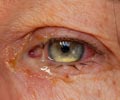Technology holds promise for other forms of Leber congenital amaurosis as well as other inherited diseases that lead to severe vision loss or blindness.

‘Testing showed a significant increase in light-induced electrical activity from the eyes to the brain, indicating the rods and cones were operating as they should in the visual cycle.’





"We believe this technology can deliver almost any type of gene to tackle inherited visual disorders," said lead researcher Zheng-Rong Lu, Professor at Case Western Reserve University in Cleveland, Ohio, US. Those with LAC2 carry a mutated RPE65 gene and suffer from profound vision loss from birth.
The mutated gene fails to produce RPE65 protein in the retinal pigment epithelium (RPE), a cell layer critical for protecting photoreceptors (rods and cones).
The protein is an essential constituent of the visual cycle that converts light to electrical signals to the brain.
Lu and colleagues designed a lipid-based nanoparticle called ECO to deliver healthy RPE65 genes to RPE cells.
Advertisement
Following injection into the retina of mice, the researchers could see fluorescent green concentrating in RPE cells.
Advertisement
The therapeutic effect lasted 120 days in treated mice and no improvements were observed in untreated mice.
"This work is important beyond one disease," Palczewski said.
"The loss of photoreceptor cells affects virtually all of us," Palczewski noted.
Source-IANS















